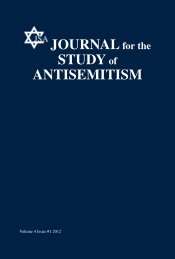Journal for the Study of Antisemitism
Journal for the Study of Antisemitism
Journal for the Study of Antisemitism
You also want an ePaper? Increase the reach of your titles
YUMPU automatically turns print PDFs into web optimized ePapers that Google loves.
214 JOURNAL FOR THE STUDY OF ANTISEMITISM [ VOL. 1:209<br />
to 2007. Many residents in <strong>the</strong>se districts are immigrants or <strong>the</strong>ir descendants,<br />
mostly from Muslim countries. Belleville and Kreuzberg in particular<br />
have a long history <strong>of</strong> accommodating immigrants, including Jewish immigrants.<br />
However, during <strong>the</strong> reign <strong>of</strong> National Socialism, almost all Jews in<br />
Kreuzberg were murdered and Jewish presence was destroyed. As a result,<br />
Jews and Jewish life are hardly visible in Kreuzberg and in <strong>the</strong> bordering<br />
district Neukölln today, except <strong>for</strong> a synagogue with a small community, <strong>of</strong><br />
which many members are not local residents. In contrast, in Belleville<br />
Orthodox Jews can be seen regularly, some local shops and cafés are owned<br />
by Jews, and, although <strong>the</strong>y are a minority, many Jews live <strong>the</strong>re, and some<br />
Jewish pupils attend local public schools, while o<strong>the</strong>rs attend Jewish faith<br />
schools. 12 In Barbès, Jewish life is far less visible than in Belleville, but<br />
much more visible than in Berlin-Kreuzberg or Neukölln.<br />
The interviews were recorded and transcribed. Relation between data<br />
collection and analysis consisted mainly in coding and finding patterns in<br />
<strong>the</strong> data. The analytical strategy is based on a five-stage method (Schmidt<br />
2004). The analysis followed procedures <strong>of</strong> qualitative content analysis<br />
using a standard procedure <strong>of</strong> inductive category <strong>for</strong>mation (Mayring 2004;<br />
Kelle 2004; Heinz et al. 1998). This paper focuses on <strong>the</strong> analysis <strong>of</strong> <strong>the</strong><br />
category <strong>of</strong> pejorative use and potential pejorative use <strong>of</strong> <strong>the</strong> words <strong>for</strong><br />
“Jew” including all relevant excerpts from <strong>the</strong> interviews. The paper largely<br />
presents <strong>the</strong> description <strong>of</strong> its subcategories and <strong>the</strong>ir relations. Interview<br />
excerpts are used to show this pejorative usage is expressed. The excerpts<br />
were selected as representative examples <strong>of</strong> <strong>the</strong> particular subcategory, trying<br />
to use examples from France and Germany equally.<br />
The cross-national comparison poses a particular problem in <strong>the</strong> analysis<br />
(Van de Vijver 1998; H<strong>of</strong>fmeyer-Zlotnik and Harkness 2005) and was<br />
met by applying special diligence regarding <strong>the</strong> influences <strong>of</strong> <strong>the</strong> national<br />
contexts and a separate pre-analysis <strong>for</strong> each country. However, <strong>the</strong> major<br />
differences <strong>of</strong> context do not allow <strong>for</strong> a completely satisfying comparative<br />
strategy. We have to bear in mind <strong>the</strong> fact that <strong>the</strong> general language usage<br />
concerning <strong>the</strong> words <strong>for</strong> “Jew” is influenced in fundamentally different<br />
ways in France and in Germany, particularly as a result <strong>of</strong> <strong>the</strong> murder <strong>of</strong><br />
European Jewry by <strong>the</strong> German National Socialists. Commonalities<br />
between <strong>the</strong> two languages regarding <strong>the</strong> pejorative use <strong>of</strong> <strong>the</strong> words <strong>for</strong><br />
“Jew” are <strong>the</strong>re<strong>for</strong>e <strong>the</strong> more surprising.<br />
In <strong>the</strong> following section, I present observations about <strong>the</strong> pejorative<br />
usage <strong>of</strong> <strong>the</strong> terms <strong>for</strong> “Jew” from <strong>the</strong> interviews. Firstly, I examine <strong>for</strong>ms<br />
and functions <strong>of</strong> <strong>the</strong> phenomenon, revealing <strong>the</strong> mechanisms and effects <strong>of</strong><br />
12. Increasingly, Jewish parents send <strong>the</strong>ir children to Jewish faith schools, possibly<br />
to avoid antisemitic harassment (Le Bars 2009).














